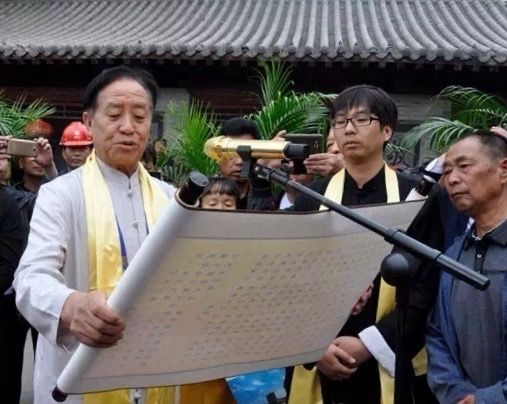 |
| Taijiquan as part of the official school sports programme |
In the last post I reported the formal induction of 13 renowned Taijiquan players as "Professors of Taijiquan", an official recognition of their roles as educators. This is part of a wider movement in China as the country looks to reassert its identity. Professor Guo Qiyong, dean of the School of Chinese Classics at Wuhan University said, "traditional culture offers China the ideological roots to develop and prosper as a nation. Without it, the Chinese will lose their identity in the trend of globalisation".
Earlier this month 26 teams, made up of more than 2,500 teachers and students from Wen County, Henan Province’s primary and secondary schools, participated in a collective display of the “Traditional Taijiquan Routine” as part of their sport education programme. Since 2001 Wen county, whose environs include Chenjiagou, has been actively promoting Taijiquan in all its primary and secondary schools - at present more than 50,000 students and teachers practise Taijiquan!
Earlier this month 26 teams, made up of more than 2,500 teachers and students from Wen County, Henan Province’s primary and secondary schools, participated in a collective display of the “Traditional Taijiquan Routine” as part of their sport education programme. Since 2001 Wen county, whose environs include Chenjiagou, has been actively promoting Taijiquan in all its primary and secondary schools - at present more than 50,000 students and teachers practise Taijiquan!
 |
| Wen County students demonstration |
It’s hard to over-emphasise the transformation that has taken
place in China over the last three decades or so. Most readers will be familiar
with the story of how practitioners of Taijiquan (and other traditional arts)
were persecuted during the Cultural Revolution. The book Essence of Taijiquan recounted how Taijiquan’s renaissance began in 1978 when Deng Xiaoping, in his
position as Vice Chairman of the People’s Republic of China, wrote the simple
words “Taijiquan Hao” or “Taijiquan is good” for a group of visiting Japanese
delegate: “An article published in Chinese Wushu magazine (2003) under the
title of “Ten Significant Events in Wushu” describes vividly the full
impact of this statement: “Deng
Xiaoping’s writing breathed new life into the development of Taijiquan as well
as other traditional Chinese martial arts.
In the previous ten years all traditional arts had stagnated and were in
danger of extinction. With the new China
(after the Cultural Revolution) all the treasures of China were awaiting their fate. Nobody was certain whether the wide variety
of martial arts would ever be able to see light again”. Even though the political climate had eased,
traditional martial arts were not a priority for the new legislation and were
in a state of limbo. People lacked the
confidence to practise openly and were waiting for a decision from higher up to
revive it. “The very positive statement
by Deng Xiaoping gave an indication to the whole of China that after the storm
of the last ten years Taijiquan was going to enter a new era of regrowth”.
 |
| In Wen County all primary and secondary school children and teachers train Taijiquan |
Taiji Culture Schools
Back in September 2015 a ceremony was held marking the
collaboration between the Chenjiagou Taijiquan School and the Jiaozuo Taiji
Specialised Secondary School. The Jiaozuo school is at the forefront of the
national implementation of China’s first Taiji-centred education schools.
The school was established with the intention of preserving and
propagating the country's ancient Taiji culture. Speaking at the event Chen
Zijun explained that with the social development of Taijiquan it is essential
to raise the quality of the martial artists coming out of the school. In
setting up a branch of The Jiaozuo Taiji School within the Chenjiagou Taijiquan
School there are obvious benefits to both sides: “This cooperation will allow
us to comprehensively develop both the civil and military talents of students.
To better carry forward the traditional martial arts while recognising and understanding
their heritage and culture”.
 |
| Chen Zijun: "Carrying forward traditional martial arts while recognising and understanding their heritage and culture". |
The reassertion of China’s traditional culture has not been
restricted to Taijiquan. In China, towards the end of last year I came across an article in the China Daily newspaper which spoke of the increasing
relevance of the ancient classics in modern classrooms. The article was
illustrated with a photo of a group of young children, dressed in the style of
the Han Dynasty that ruled China 1,800
years ago, reciting the Analects of Confucius. The article followed 6-year-old
Chen Quanjin as he spent his summer vacation doing traditional Chinese studies
at the Chenxiang Guoxue Institute in Guozijian: “Chen Quanjin has mastered the Dizigui,
a Chinese book dating back more than 300 years that lays out standards for
being a good child and student. He says the three-character verses are
understandable and trip of the tongue - “Older siblings should befriend younger
ones; younger siblings should respect and love older ones. Siblings who keep
harmonious relationships among themselves are being dutiful to their parents”.
 |
Pupils in traditional Han costumes reciting the Analects of Confucius during a ceremony marking the 2,565th anniversary of the birth of the ancient philosopher
|
This resurgence of interest in traditional culture has backing
from the highest places: "In April 2014, China's Ministry of Education issued a guideline for teaching traditional culture from primary school through college. It required more lessons on traditional culture to be included in primary and middle school textbooks. President Xi Jinping echoed this view when he visited Beijing Normal
University in September 2014. He voiced disapproval of [previous] decisions to remove
Chinese poems and essays from textbooks saying that: “China’s cultural genes
should be planted in the minds of the young”. It appears that the reversal of the excesses of the Cultural Revolution is well underway.










